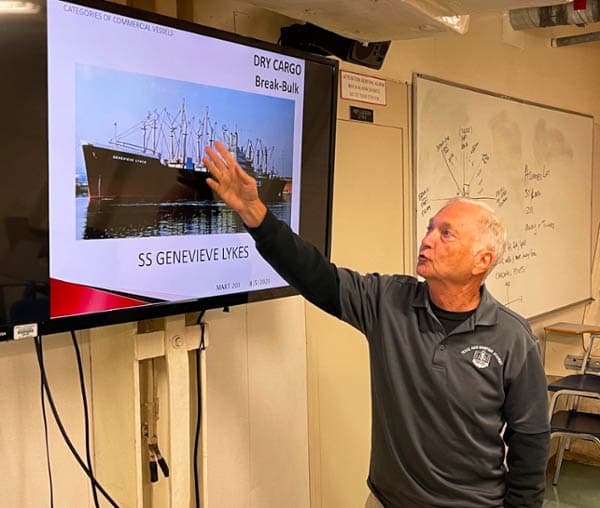Love at First Sight Lines
August 18, 2021
Tweet
By Andréa Bolt, Communications Specialist, Division of Marketing & Communications
The Vietnam War might be an odd backdrop in which to find love, but Texas A&M Maritime Academy Department of Maritime Transportation (MART) Professor and Captain Tim Nelick claims that is exactly what happened to him during one fateful watch shift.
The year is 1970 and United States Navy Midshipman Nelick is far from home. The air is thick with humidity, but not quite heavy enough to muffle the staccato pop of bombs dropping in the near distance of Da Nang.
He stands watch aboard the USS Cleveland, an amphibious Landing-Transport Docking (LPD-7), class seven vessel . The muddy water is still, but Nelick keeps his head on a swivel, taking his job as silent sentinel seriously.
That is when he saw her. It was love, he says, at first sight lines.
“I looked across the dock and I spied this absolutely marvelous ship, she was just beautiful,” Nelick describes.
That vessel was the SS Genevieve Lykes, sister vessel to the SS Velma Lykes, better known to followers of the Texas A&M Maritime Academy as the T/S Kennedy.
Nelick, now a MART engineering professor, said the SS Genevieve Lykes took his breath away. She also gave him purpose.
“I had never seen a merchant ship in my life,” he recalls. “But after laying eyes on her and those clean lines, I knew that was what I wanted to do.”
Years later, Nelick would return to his golden girl. He served as second mate aboard the SS Genevieve Lykes for a few weeks, but he “still had things to do, places to see.”
Sailing now aboard the T/S Kennedy brings about a fair share of reminiscing for Nelick. The sisters share many of the same “graceful” touches. According to Nelick, the Kennedy is not quite as nice as her sister, and the changes made – accommodations added – have changed her look somewhat.
“But she still rides well and is a very comfortable ship, especially anywhere in the old accommodation house. The crew mess and directly, vertically up above to the wheelhouse, is the old ship and the engine room is the original engine room.”
Nelick says he even recently spoke with a cadet whose father sailed on the SS Louise Lykes, another one of the sisters. There were twelve Lykes vessels originally built in New Orleans' Avondale Shipyards in 1967. The entire family of the Far East Clipper class includes the Louise Lykes, Elizabeth Lykes, Ruth Lykes, Mason Lykes, Mallory Lykes, Stella Lykes, Howell Lykes, Frederick Lykes, Genevieve Lykes, Letitia Lykes and Dolly Turman.
The others are nice, but Nelick still remembers his first love. As steam ships begin to go the way of the dodo, replaced by more technologically advanced vessels, Nelick says he will still recall her fondly.
“It’s true, you know, what they say, now even more so. They just don’t make them like that anymore.”
###
Media contact:Communications Specialist
a_bolt@tamug.edu
More:
Read more about Maritime Administration
Read more about Maritime Transportation
Read more about Texas A&M Maritime Academy